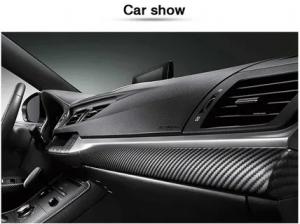Automotive Plastic Interior Trims Market to Reach USD 63.77 Billion by 2035 Amid Shift Lightweight & Vehicle Designs
Automotive plastic interior trims market grows on lightweight, durable, and aesthetic solutions for vehicle interiors, driven by rising auto production.
As automakers increasingly prioritize fuel efficiency and emissions compliance, plastic interior trims offer a viable solution to reduce vehicle mass without compromising structural integrity. These materials are also easier to mold into complex shapes, allowing manufacturers to create more sophisticated and ergonomic cabin designs. Moreover, advancements in surface finishing techniques, such as laser texturing and soft-touch coatings, are elevating the sensory and visual appeal of plastic trims. The rapid growth of electric vehicles (EVs) and premium compact cars is contributing to the rising use of sustainable and recycled plastics, as brands seek to align with environmental standards and consumer preferences for eco-conscious mobility. In parallel, the integration of smart technologies into interior surfaces, such as ambient lighting and touch-sensitive controls, is further driving innovation in plastic trim applications.
Get Ahead with Our Report: Request Your Sample Now!
https://www.futuremarketinsights.com/reports/sample/rep-gb-9056
Key Takeaways from the Automotive Plastic Interior Trims Market:
The global market is anticipated to grow from USD 32.1 billion in 2025 to USD 63.8 billion by 2035, driven by a 7.1% CAGR. Lightweight plastic trims play a vital role in meeting fuel economy targets and carbon emission standards, especially as governments tighten environmental regulations. Passenger vehicles represent the largest application segment due to the rising demand for premium interiors across both mass-market and luxury segments. Original equipment manufacturers (OEMs) dominate the market share, although the aftermarket segment is also growing, particularly in regions with older vehicle fleets and increased demand for refurbishment. Asia Pacific leads the global market, underpinned by strong vehicle production in China, India, Japan, and South Korea, while Europe and North America continue to show robust demand for high-performance, customizable interior components.
Emerging Trends in the Global Automotive Plastic Interior Trims Market:
One of the most prominent trends in the market is the increasing use of recycled and bio-based plastics to enhance sustainability while maintaining performance. Automakers are working with suppliers to develop interior trims that meet both environmental benchmarks and aesthetic expectations. Additionally, digital design and simulation tools are being adopted to accelerate prototyping and reduce time-to-market for new trim designs. The growing popularity of minimalist and tech-integrated cabin layouts is encouraging the use of lightweight, modular plastic trims that can house infotainment systems, integrated touch panels, and dynamic lighting features.
There is also a marked trend toward customizable interiors, with plastic trims playing a central role in delivering unique textures, colors, and finishes to match consumer lifestyle preferences. The rise of electric and autonomous vehicles is further influencing interior trim design, with greater focus on user-centric cabin spaces that emphasize comfort, personalization, and intuitive control layouts. Enhanced material innovations, such as scratch-resistant and anti-microbial surfaces, are being incorporated to improve durability and hygiene in high-touch areas.
Significant Developments in the Global Sector: Trends and Opportunities in the Market:
Several key developments are reshaping the market landscape. OEMs are increasingly partnering with Tier 1 and Tier 2 suppliers to co-develop next-generation trim components that support modular vehicle platforms and smart cabin technologies. These partnerships are enabling faster integration of innovations such as backlit panels, translucent materials, and advanced acoustic solutions, which enhance both functionality and cabin ambiance. The rising use of Industry 4.0 technologies—including automation, robotics, and additive manufacturing—is allowing for more precise and cost-effective production of intricate trim parts.
Opportunities abound in developing markets, where increasing vehicle ownership, urbanization, and disposable income are spurring demand for enhanced in-cabin experiences. Additionally, the premium segment is witnessing strong interest in luxury-grade plastic trims with metallic finishes and leather-like textures, providing high-end appeal without the associated weight or cost. Regulatory support for vehicle recyclability and sustainability is also prompting manufacturers to invest in closed-loop systems and green material sourcing.
Recent Developments in the Market:
The last few years have witnessed several notable product launches and expansions in the plastic interior trims space. Major suppliers have introduced new material blends that combine strength, flexibility, and reduced environmental impact. For instance, the use of fiber-reinforced polymers and hybrid composites is gaining traction for applications that demand high performance under dynamic loads. Global players have also expanded production capacities in emerging markets to meet growing regional demand and reduce logistics costs.
Automakers are actively experimenting with multi-material trims that incorporate electronic features such as touch sensors, haptic feedback, and integrated displays. The use of soft foams and 3D-printed textures is being explored to enhance tactile quality and passenger engagement. In line with the smart mobility trend, several OEMs have announced interior concepts that eliminate traditional switches in favor of seamless, sensor-embedded plastic panels.
Detailed Market Study: Full Report and Analysis
https://www.futuremarketinsights.com/reports/automotive-plastic-interior-trims-market
Competition Outlook:
The automotive plastic interior trims market is moderately fragmented, with a mix of global giants and specialized regional players competing on quality, customization, cost, and sustainability. Leading companies are focusing on product differentiation through innovative surface treatments, sustainable materials, and integration with smart technologies. Strategic alliances, acquisitions, and investments in localized manufacturing are common approaches to strengthen market position and enhance responsiveness to OEM requirements.
Key Players
Key players in the global automotive plastic interior trims market include Faurecia, Grupo Antolin, Lear Corporation, International Automotive Components (IAC) Group, Toyota Boshoku Corporation, Magna International Inc., Visteon Corporation, Yanfeng Automotive Interiors, Trinseo S.A., and DURA Automotive Systems. These companies are driving market innovation through design expertise, global supply networks, and R&D in lightweight and recyclable plastics.
Key segmentations
The market is segmented by material type (polypropylene, ABS, polycarbonate, PVC, others), by application (dashboard, door panels, center consoles, pillars, others), by vehicle type (passenger vehicles, light commercial vehicles, heavy commercial vehicles), and by sales channel (OEM and aftermarket). Among these, dashboards and door panels are expected to remain the largest application areas due to high surface area utilization and frequent consumer interaction. OEMs will continue to lead in volume and revenue, while aftermarket demand will remain strong in markets with older vehicle populations and personalization trends.
Automotive Interior Industry Analysis Reports
Automotive Interior Ambient Lighting System Market Forecast and Outlook from 2025 to 2035
https://www.futuremarketinsights.com/reports/automotive-interior-ambient-lighting-systems-market
Automotive Load Floor Market Forecast and Outlook from 2025 to 2035
https://www.futuremarketinsights.com/reports/automotive-load-floors-market
Bus Flooring Market Forecast and Outlook from 2025 to 2035
https://www.futuremarketinsights.com/reports/bus-flooring-market
Automotive HVAC Blower Market Size and Share Forecast Outlook (2025 to 2035)
https://www.futuremarketinsights.com/reports/automotive-hvac-blower-market
Automotive Soft Trim Interior Materials Market Forecast and Outlook from 2025 to 2035
https://www.futuremarketinsights.com/reports/automotive-soft-trim-interior-materials-market
Ankush Nikam
Future Market Insights, Inc.
+ +91 90966 84197
email us here
Visit us on social media:
LinkedIn
Facebook
YouTube
X
Legal Disclaimer:
EIN Presswire provides this news content "as is" without warranty of any kind. We do not accept any responsibility or liability for the accuracy, content, images, videos, licenses, completeness, legality, or reliability of the information contained in this article. If you have any complaints or copyright issues related to this article, kindly contact the author above.
Peaking Power Plant Market Size to Nearly Double to $89 Billion by 2034, Growing at 7.5% CAGR
Upcoming National Senior Citizens Day: Equity Access Group Reaffirms Its Commitment to Helping Seniors Age in Place
Reclaim247 Expands Car Finance Claims Service Amid Surge in Consumer Reviews of PCP Agreements
Więcej ważnych informacji
 Jedynka Newserii
Jedynka Newserii

 Jedynka Newserii
Jedynka Newserii

Ochrona środowiska

A. Bryłka (Konfederacja): Ograniczenie emisyjności nie musi się odbywać za pomocą celów klimatycznych. Są absurdalne, nierealne i niszczące europejską gospodarkę
W lipcu br. Komisja Europejska ogłosiła propozycję nowego celu klimatycznego, który zakłada ograniczenie emisji gazów cieplarnianych o 90 proc. do 2040 roku w porównaniu do stanu z 1990 roku. Został on zaproponowany bez zgody państw członkowskich, w przeciwieństwie do poprzednich celów na 2030 i 2050 rok. Polscy europarlamentarzyści uważają ochronę środowiska i zmiany w jej zakresie za potrzebne, jednak nie powinny się odbywać za pomocą nieosiągalnych celów klimatycznych.
Polityka
Dramatyczna sytuacja ludności w Strefie Gazy. Pilnie potrzebna dobrze zorganizowana pomoc humanitarna

Według danych organizacji Nutrition Cluster w Strefie Gazy w lipcu br. u prawie 12 tys. dzieci poniżej piątego roku życia stwierdzono ostre niedożywienie. To najwyższa miesięczna liczba odnotowana do tej pory. Mimo zniesienia całkowitej blokady Strefy Gazy sytuacja w dalszym ciągu jest dramatyczna, a z każdym dniem się pogarsza. Przedstawiciele Polskiej Akcji Humanitarnej uważają, że potrzebna jest natychmiastowa pomoc, która musi być dostosowana do aktualnych potrzeb poszkodowanych i wsparta przez stronę izraelską.
Polityka
Wśród Polaków rośnie zainteresowanie produktami emerytalnymi. Coraz chętniej wpłacają oszczędności na konta IKE i IKZE

Wzrosła liczba osób, które oszczędzają na cele emerytalne, jak również wartość zgromadzonych środków. Liczba uczestników systemu emerytalnego wyniosła w 2024 roku ponad 20,8 mln osób, a wartość aktywów – 307,5 mld zł – wynika z najnowszych danych Urzędu Komisji Nadzoru Finansowego (UKNF). Wyraźny wzrost odnotowano w przypadku rachunków IKE i IKZE, na których korzyść działają m.in. zachęty podatkowe. Wpłacane na nie oszczędności są inwestowane, a tym samym wspierają gospodarkę i mogą przynosić atrakcyjną stopę zwrotu.
Partner serwisu
Szkolenia

Akademia Newserii
Akademia Newserii to projekt, w ramach którego najlepsi polscy dziennikarze biznesowi, giełdowi oraz lifestylowi, a także szkoleniowcy z wieloletnim doświadczeniem dzielą się swoją wiedzą nt. pracy z mediami.








.gif)

 |
| |
| |
|